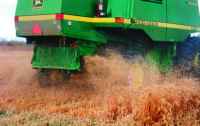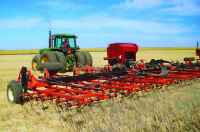| | Spreading crop residues | Removing straw and chaff | Handling difficult residue conditions
Crop residues include straw, chaff and roots. Crop type, variety and yield influence the amount of crop residue produced (Table 3.2). Crop residues can benefit a crop production system, but straw and chaff require proper management.
Spreading Crop Residues
Retaining the straw and chaff on the surface of a field offers many benefits. These include increased snow catch and water infiltration, reduced evaporation, increased soil organic matter, improved soil structure and plant nutrient cycling, decreased erosion, and reduction of some weed species.
In direct seeding, crop residues must be spread evenly to avoid or reduce such problems as: equipment plugging; poor seed germination; disease, weed and insect infestations; nitrogen tie-up in the chaff or straw rows; and cold soil.

The most practical way to manage crop residues is with the combine.
Courtesy of RTL
Key techniques to manage residues in direct seeding systems include the following:
- The most practical way to manage chaff and straw residue is with the combine.
- Residue should be spread uniformly over the entire width of the header cut.
- Harrowing can spread straw but not chaff.
- If harrowing, it is better to harrow in the fall before the straw settles.
- Increased residue clearance of direct planting equipment is crucial.
Removing Straw and Chaff
The value of straw and chaff differs greatly from area to area. Deciding whether to sell straw for short-term economic returns or to retain straw on a field to sustain long-term soil productivity can be difficult. Consider the following factors in your decision:
- If the risk of wind or water erosion is moderate to severe, do not remove straw.
- Do not remove straw in drought-prone areas.
- Chaff removal is an option in many areas because chaff does not have much erosion control benefit and is a source of weed seeds.
- If the soil is low in organic matter, retain crop residues.
- Crop residues contain economically significant amounts of macronutrients. However, the actual nutrient contents vary greatly. Test samples for an accurate assessment.
Handling Difficult Residue Conditions
High crop yields and unusual weather often leave hard-to-handle crop residue conditions such as crops not harvested due to hail, severe frost or other damage, lodged or snow-flattened crops and crops producing heavy residues such as viny pea crops, sunflowers and flax.
Options for managing residues in these difficult conditions include:
- Harrowing: Harrows spread straw, press loose straw into the soil surface, and disperse straw clumps. This reduces plugging in direct seeding planters.
- Mowing: Even very heavy residue or very tall standing stubble is not usually a problem if it is mowed or shredded. However, mowing can be expensive.
- Tillage: If you decide to till, then you must use enough tillage to mix the straw into the soil so that the planter's ground openers will work without plugging. The first tillage pass after harvest leaves a very poor seed bed condition. Tillage should be followed by harrows or packers to reduce soil moisture loss. Waiting until spring to till allows the residues to break down over the winter.
- Baling: Baling is an option for handling excessive residues.

Harrows can spread straw to reduce plugging in direct seeding planters.
Courtesy of ARD
Back to Chapter 3 - Cropping Practices |
|